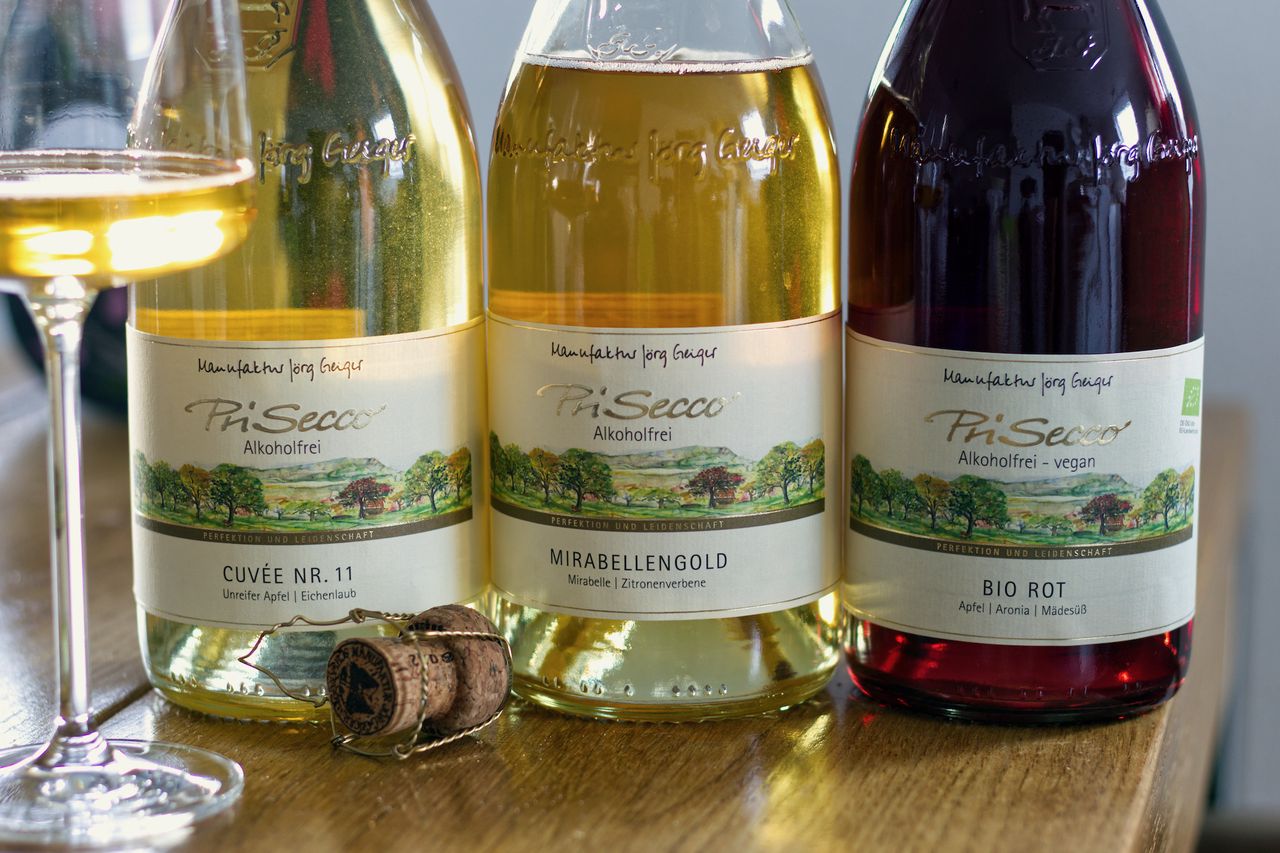Three Bottles Jörg Geiger
We drink three bottles of alcohol-free PriSecco from Jörg Geiger: Mirabellengold, Bio Rot and the Cuvee No. 11.

About two weeks ago we already had three non-alcoholic alternatives in our glasses and now we’re doing it again. Instead of tea as the base, however, this time it’s fruit juices. Jörg Geiger produces a large number of different types of PriSecco from old varieties of fruit from the meadows on the edge of the Swabian Alb and all kinds of herbs and other juices. There are PriSeccos that are available all year round and others that are only available seasonally. It’s not easy to make a choice here. This time, we decided on Cuvée No. 11 made from unripe apple and oak leaves, Mirabellengold with mirabelle plum and lemon verbena and Bio Rot made from apple, chokeberry and meadowsweet. All varieties are the result of the same philosophy, in which Jörg Geiger has made it his goal to preserve the cultural landscape of the meadow orchards with their varieties and typical vegetation. At the latest during a walk through the meadows directly bellow the schwäbische Alb, one also understands that this is worthwhile and how important the preservation of this cultural landscape is for the region here. Like last time, we didn’t open all the bottles at the same time, but drank them one after the other over the last few days.
We start with Mirabellengold. The fruit on the nose is ripe and yellow, you can smell the apple juice and it reminds you of lemon balm. We’ve had this before with verbena in the Sparkling Tea and attributed it to the fact that we’ve never tried verbena on its own. There is quite a lot going on in the nose, even though we would never have identified the rosemary and tarragon contained according to the label. In the mouth, the PriSecco is juicy and clear. The acidity is there, but it does taste quite sweet. We don’t mind it directly after or with food, but on its own it’s a touch too much.
We continue with Bio Rot. Here, too, you can taste and smell the high proportion of apple juice, of course, but behind that there’s a lot going on. A mixture of red berries and sour cherry. Reminiscent of woodruff jelly, it has a great structure and a strong acidity. We blame it on the chokeberry, that there is much more depth here than in the first bottle. Tart, fresh, the currant comes in and everything has an amazing length. Tastes like a much more exciting version of a currant spritzer. It’s hard to get the nose out of the glass. We really enjoy this.
Finally, the Cuvée No. 11. Apple juice, and with it of course the taste of apple, plays an important role in all three bottles, but here it really shines. The acidity is great and right on point. The fruit is super clear and super fresh. I can’t really tell that there are oak leaves in it, but then I chew on oak leaves relatively rarely. Maybe I should try it sometime. But what is there, what you can feel, and what I attribute to the oak leaves, is a tart spiciness that offers a great counterbalance to the fruit. The 92 grams of sugar per litre are extremely well integrated. Out the back, it even reminds me of stewed apples with a slight hint of cinnamon and apple core. This combination is really, really good.
What it is not however, is sparkling wine without alcohol. The sweetness is a real balancing act, especially when the sparkling wines you usually drink often come without any dosage at all. You have to search, taste and some varieties are simply too sweet. Simply don’t buy them again. And of course the mouthfeel, the bubbles, can’t compete with many years of bottle fermentation. But they don’t have to. To have fun here, you have to free yourself from these comparisons. If you can do that and see it for what it is, namely an unusual fruit juice combination with bubbles, a category of drink all its own, then, yes, you can make some really great discoveries here.